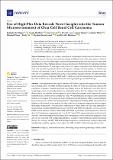Files in this item
Use of high-plex data reveals novel insights into the tumour microenvironment of clear cell renal cell carcinoma
Item metadata
| dc.contributor.author | De Filippis, Raffaele | |
| dc.contributor.author | Wolflein, Georg | |
| dc.contributor.author | Um, In Hwa | |
| dc.contributor.author | Caie, Peter David | |
| dc.contributor.author | Warren, Sarah | |
| dc.contributor.author | White, Andrew | |
| dc.contributor.author | Suen, Elizabeth | |
| dc.contributor.author | To, Emily | |
| dc.contributor.author | Arandelovic, Oggie | |
| dc.contributor.author | Harrison, David James | |
| dc.date.accessioned | 2022-11-01T15:30:11Z | |
| dc.date.available | 2022-11-01T15:30:11Z | |
| dc.date.issued | 2022-11-01 | |
| dc.identifier | 281907553 | |
| dc.identifier | c3be3f23-1554-46c2-a0dc-15d25fb309b5 | |
| dc.identifier | 85141816603 | |
| dc.identifier | 000880925200001 | |
| dc.identifier.citation | De Filippis , R , Wolflein , G , Um , I H , Caie , P D , Warren , S , White , A , Suen , E , To , E , Arandelovic , O & Harrison , D J 2022 , ' Use of high-plex data reveals novel insights into the tumour microenvironment of clear cell renal cell carcinoma ' , Cancers , vol. 14 , no. 21 , 5387 . https://doi.org/10.3390/cancers14215387 | en |
| dc.identifier.issn | 2072-6694 | |
| dc.identifier.other | ORCID: /0000-0001-9041-9988/work/122215843 | |
| dc.identifier.other | ORCID: /0000-0002-0031-9850/work/122216039 | |
| dc.identifier.other | ORCID: /0000-0002-0407-7617/work/122216825 | |
| dc.identifier.other | ORCID: /0000-0001-9999-4292/work/158122924 | |
| dc.identifier.uri | https://hdl.handle.net/10023/26287 | |
| dc.description | Funding: This work was supported by Medical Research Scotland (MRS), NHS Lothian, NanoStringTechnologies, and the Industrial Centre for AI Research in Digital Diagnostics (iCAIRD) which is funded by Innovate UK on behalf of UK Research and Innovation (UKRI) [project number: 104690]. | en |
| dc.description.abstract | Although Immune Checkpoint Inhibitors (ICIs) have significantly improved the oncological outcomes, about one third of patients affected by Clear Cell Renal Cell Carcinoma (ccRCC) still experience recurrence. Current prognostic algorithms like the Leibovich Score (LS) rely on morphological features manually assessed by pathologists, and are therefore subject to bias. Moreover, these tools do not consider the heterogeneous molecular milieu present in the Tumour Microenvironment (TME), which may have prognostic value. We systematically developed a semi-automated method to investigate 62 markers and their combinations in 150 primary ccRCCs using multiplex Immunofluorescence (mIF), NanoString GeoMx® Digital Spatial Profiling (DSP) and Artificial Intelligence (AI)-assisted image analysis in order to find novel prognostic signatures and investigate their spatial relationship. We found that coexpression of Cancer Stem Cell (CSC) and Epithelial-to-Mesenchymal Transition (EMT) markers such as OCT4 and ZEB1 are indicative of poor outcome. OCT4 and the immune markers CD8, CD34 and CD163 significantly stratified patients at intermediate LS. Furthermore, augmenting the LS with OCT4 and CD34 improved patient stratification by outcome. Our results support the hypothesis that combining molecular markers has prognostic value and can be integrated with morphological features to improve risk stratification and personalised therapy. To conclude, GeoMx® DSP and AI image analysis are complementary tools providing high multiplexing capability required to investigate the TME of ccRCC, while reducing observer bias. | |
| dc.format.extent | 20 | |
| dc.format.extent | 7365216 | |
| dc.language.iso | eng | |
| dc.relation.ispartof | Cancers | en |
| dc.subject | Multiplex | en |
| dc.subject | Immunofluorescence | en |
| dc.subject | Nanostring | en |
| dc.subject | Image analysis | en |
| dc.subject | Pathology | en |
| dc.subject | Kidney | en |
| dc.subject | Spatial analysis | en |
| dc.subject | QR180 Immunology | en |
| dc.subject | RC0254 Neoplasms. Tumors. Oncology (including Cancer) | en |
| dc.subject | NDAS | en |
| dc.subject | SDG 3 - Good Health and Well-being | en |
| dc.subject | MCC | en |
| dc.subject.lcc | QR180 | en |
| dc.subject.lcc | RC0254 | en |
| dc.title | Use of high-plex data reveals novel insights into the tumour microenvironment of clear cell renal cell carcinoma | en |
| dc.type | Journal article | en |
| dc.contributor.sponsor | Innovate UK | en |
| dc.contributor.institution | University of St Andrews. Cellular Medicine Division | en |
| dc.contributor.institution | University of St Andrews. School of Computer Science | en |
| dc.contributor.institution | University of St Andrews. School of Medicine | en |
| dc.contributor.institution | University of St Andrews. Sir James Mackenzie Institute for Early Diagnosis | en |
| dc.contributor.institution | University of St Andrews. Centre for Biophotonics | en |
| dc.identifier.doi | https://doi.org/10.3390/cancers14215387 | |
| dc.description.status | Peer reviewed | en |
| dc.identifier.url | https://www.mdpi.com/2072-6694/14/21/5387 | en |
| dc.identifier.grantnumber | TS/S013121/1 | en |
This item appears in the following Collection(s)
Items in the St Andrews Research Repository are protected by copyright, with all rights reserved, unless otherwise indicated.

